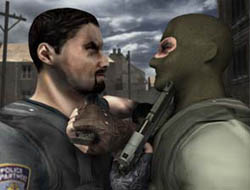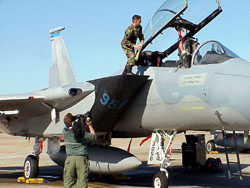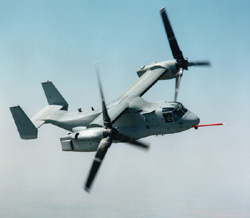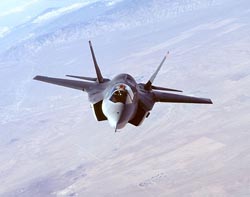Page 1
Daily News
By Gail Helmer
| Send Us News | Archives | Main |
Monday March 25, 2002
PC News
- New Screens: Task Force Dagger
- Strategy First to Publish G.I. Combat
- New World Order Public Multiplayer Beta
- Activision to Publish Starfleet Command III
- American Fighter Pilot Series Takes Flight On CBS
- MV-22 Osprey Flight Testing Slated to Resume
- US Navy And Marine Corps Consider Cuts In JSF Numbers
- Roll-Out of the First Production Tiger Combat Helicopter
- UK Army's New Helicopter Cannot Fire Missiles
New Screens: Task Force Dagger
NovaLogic has released more details on the forthcoming stand-alone Mission Pack for Delta Force Land Warrior. The game fiction is based on missions from Operation Enduring Freedom. Take control as 1 of 10 different Special Forces soldiers over 25 intense and varied missions set in Afghanistan. Only the best of the best are selected to become members of the 2/75th RANGER, SEAL Team 6, CIA Spec Ops, the UK SAS 22 Regiment, SFOD-SF Viper Team (Green Berets), Australian SASR, Canadian JTF-2, Marine Force Recon, USAF CSAR (Air Force Pararescue) and of course SFOD-DELTA. Screens
Missions take place deep in enemy territory, from Kandahar to Mazar-i-Sharif to Tora Bora. Delta Force Operatives raid rebel headquarters, take control of a local airport, ambush enemy convoys and destroy key SAM and SCUD missile sites. Utilizing NovaLogic's updated Land Warrior engine, Task Force Dagger has been designed by Zombie Studios as a stand-alone mission pack with new characters, weapons and single and multiplayer levels. Release Date: May 2002.
Strategy First to Publish G.I. Combat
Strategy First and Freedom Games announced that they have entered into a North American publishing agreement for the G.I. Combat series, the next generation of real-time historical strategy gaming. The first release will be G.I. Combat: Episode I, Normandy. Players will be fighting to hold vital crossroads and attempt to better the performance of their historical counterparts. With a detailed individual soldier model, consisting of 8 different psychological states and morale, players will have to take into account the effects of combat on the performance of their men. An accurate physics model allows G.I. Combat to model unprecedented levels of realism for both infantry and vehicle combat. Screens
Each weapon has over 40 different data entries for ballistics, rate of fire, armor penetration, etc. Each vehicle is modeled in 3D, simulating all aspects of armor, including thickness, slope and hardness. Detail includes realistic ammunition load-outs, weapon performance and crew capacities for all type of vehicles present during the conflict in June 1944. Many different squad types will be available allowing the user greatly diversified organizations of their fighting forces. [More...]
New World Order Public Multiplayer Beta
Project Three today announced that starting Tuesday March 26th 12.00 CET. the highly anticipated Public Multiplayer Beta of the next-gen tactical first person shooter New World Order will be downloadable for public use at the following location.
The beta-version features the huge level 'Sweden', a small nordic village with several squares, streets and bridges, as well as small alleys connecting several areas. Lots of houses are accessible, including 2nd floors and even rooftops, supplying the player with sniper and ambush positions. In short, an ideal playing ground for everyone who loves tactical shooters.
New World Order is very much on track for a release end of may 2002. Upon release the game will feature both single- and multiplayer modes, tons of realistic weapons and several new game modes, in twelve big levels. "Our revolutionary DVA-engine is providing uncanny graphics at very high framerates, which combined with slick gameplay and super-realism, really takes the FPS genre to the next level", said Lead programmer Jim Malmros of Termite Games.
Activision to Publish Starfleet Command III
Activision has announced that they will publish Star Trek: Starfleet Command III. A tactical starship simulator, Starfleet Command III will be the first title in the series to take place in the Star Trek: The Next Generation timeline. Starfleet Command III is expected to be available this holiday season. Similar to the earlier games in the SFC franchise, Starfleet Command III allows gamers to optimize their ship and allocate power to their ship's systems for different types of strategies such as hit-and-run maneuvers, ambushes or direct assaults. However, Starfleet Command III simplifies this process by introducing a new interface for system management that reduces the micromanagement of starship control and allows players to focus on combat. Additionally, players can customize their vessel’s weapons, engines, shields and other systems. As players progress through the game, they can acquire stronger phasers, disruptors and shields, and outfit their ship with new weapons.
Military News
American Fighter Pilot Series Takes Flight On CBS
A national television audience will get an insider's view of what it takes to become an F-15 Eagle pilot when CBS airs a new reality-based series later this month. After nearly two years of serving as a filming location, the training mission here is about to fly into the living rooms of millions of Americans when "American Fighter Pilot" premieres March 29 at 8 p.m. EST/PST and 7 p.m. CST.
Each week, viewers will see the professional and personal challenges F-15 student pilots face during 110 days of training. The series features in-depth interviews with student pilots, instructor pilots and academic instructors who trained the student pilots.
Tony Scott, director of "Top Gun," and Ridley Scott of "Black Hawk Down" fame are among the executive producers. Documentary filmmaker Jesse Negron and Brian Gadinski, the first producer of the series "America's Most Wanted," are executive producers on the project.
Fully supported by the Air Force, the filming crew spent more than 18 months around the clock here, shadowing the aspiring fighter pilots.
To get the necessary aerial footage, crews filmed from the back seats of F-15s and affixed cameras to aircraft to capture hours of aerial combat training sessions. The filming did not end there, however. Besides from-the-cockpit shooting, the aspiring F-15 pilots were followed everywhere -- from their homes and churches to local businesses -- in a maximum effort to get inside the training, culture and lifestyles of fighter pilots.
"I believe the Air Force is in uncharted territory when it comes to 'American Fighter Pilot,'" said Lt. Col. David Freaney, 1st Fighter Squadron commander, who was the operations officer at the 95th Fighter Squadron here when the (pilots) were students in the F-15 basic course. "The timing is perfect. Take a little patriotic spirit, combine that with the rise of reality TV and throw in some of the best flying scenes that have ever been documented, and you have a can't-lose formula for success."
MV-22 Osprey Flight Testing Slated to Resume
Defense officials plan to resume flight-testing the MV-22 Osprey tilt-rotor aircraft at the end of April, according to the department's acquisition chief. But Peter Aldridge, undersecretary of defense for acquisition, technology and logistics, qualified DoD's approach to reporters today at a Pentagon roundtable discussion: He won't approve the resumption of flight testing until he's satisfied the test plan meets all the necessary criteria and all the recommendations that study panels made after two Osprey crashes that killed 23 service members.
After the second crash, in April 2000, defense officials canceled the Osprey flight-testing program and limited production to "the minimum sustaining level," Aldridge said. Marine officials also relieved the commander of the Osprey squadron at New River Marine Corps Air Station, N.C., following allegations he ordered personnel to falsify maintenance records.
"The Navy secretary and I will have a final 'return-to- flight' review before it actually starts flight testing," Aldridge said. The test program will be "event-driven," not schedule-driven, he stressed -- if some test points need to be repeated, they'll be repeated.
If we see some problems occurring early in the flight test program, we may not continue it," he said. "We could stop and head off in another direction."
Aldridge said Marine Commandant Gen. Jim Jones insisted on having alternative aircraft in case the Osprey runs into a problem. Defense officials are looking at several, including an upgraded versions of the CH-53 and UH-60 helicopters.
The commandant is "serious about reviewing alternatives," Aldridge stressed. "We all hope the V-22 is going to be successful, but in case it is not, he has to have something in place to replace their aging helicopters."
US Navy And Marine Corps Consider Cuts In JSF Numbers
Pete Aldridge, Under-secretary of Defense for acquisition, technology and logistics, spoke about JSF, during a Pentagon roundtable with reporters. The Navy recently completed a tactical air requirements study mandated by the 2001 Defense Planning Guidance. The study "validated the absolute necessity of the Joint Strike Fighter," he said. "They have to have it, both the Navy and the Marine Corps."
The study, which has not yet been reviewed or approved by Defense Department officials, recommends about a 30 percent cut in the number of fighters the Navy and Marine Corps plan to buy. Despite the study's findings, Aldridge assured reporters, "This is not a programme that is going down the drain. I'll guarantee you that."
"This study will not have any impact on the force structure of the Navy and Marine Corps until the year 2020," he explained. "It has no effect upon the development programme for the next four or five years. It has no effect upon the production programme until the year 2012."
It's difficult to predict what the military will need in the year 2020, he said. But the Quadrennial Defense Review process requires DoD officials to "anticipate uncertainty and surprise." It might turn out the military can get by with fewer fighters because of the JSF's "phenomenal" sortie rate, reliability and availability, he noted.
"The world can change in the next two years," Aldridge said. "That's what happened with the B-2 and the bomber forces." Generally, he noted, the bomber's capabilities these days take second place to its munitions' ability to destroy targets effectively.
He also commented on the other countries who intend to become partners in developing the Joint Strike Fighter, a family of three aircraft designed to replace aircraft in the Air Force, Navy, Marine Corps and the British military.
"We've been very pleased with the response from the international partners on the Joint Strike Fighter," Aldridge said.
Level 1 is for "highly active partners," he said, such as the United Kingdom, which has contributed $2 billion for JSF programme development. "They were involved with the source selection process, and they have people in the project office," he said.
Level 2 partners contribute $800 million to $1 billion, he said, and Italy and the Netherlands are in the final processes of approving their partnership. "Their cabinets have approved joining and they've now taken it to their parliament. A decision is expected by the second week in April."
Level 3 partners contribute about $150 million to participate in the aircraft's development. Aldridge said Canada signed up in February, while Denmark, Norway and Turkey have announced their intent to join.
Singapore has also expressed interest in the JSF, he said. At a recent air show there, Singaporean officials talked about how they might participate, "whether as an industrial partner or as a participant in some type of study," he said. "We've invited them to come."
US officials expect still more countries will come on board, he said, noting that the number of partners will not affect the aircraft's unit cost. The original estimate was based on the United States and United Kingdom buying a total of 3,000 aircraft.
"We're anticipating that the international buy will be in the thousands," Aldridge added.
US defence officials are pursuing other opportunities for international co-operation. Aldridge said some cooperative programmes are already in place, such as the Medium Extended Air Defence System with Germany and Italy, and the Alliance Ground Surveillance System with NATO.
He talked about a group that looks for things that are meaningful in the international arena to cooperate on. "We're looking for opportunities that would make a difference and to do things together without getting into export control hassles," he said.
"We're looking for other opportunities centred around things like unmanned aerial vehicles, air-to-air refuelling and combat identification. We've found our allies are quite good at building smaller, more mobile ships because they have smaller waters to defend. In fact, we're leasing a Norwegian ship and an Australian ship to do some experimentation."
Next month, the United States is hosting a conference on international co-operation with the United Kingdom, France, Germany and Italy.
"The Joint Strike Fighter is obviously going to be high on everybody's list," Aldridge concluded.
Roll-Out of the First Production Tiger Combat Helicopter
Series production of the Franco-German Tiger combat helicopter - one of Europe's most important helicopter programmes - is in full swing at Eurocopter's Marignane and Donauwrth plants.
In the presence of more than 500 guests from politics, armed forces, industry and media from all over the world, the roll-out of the first production Tiger in UHT configuration took place at Eurocopter's German facility in Donauwrth on March 22, 2002.
Klaus-Guenther Biederbick, Federal German Secretary of State for Defence, and Yves Gleizes, French Delegue General pour L'Armement, emphasised, at the roll-out ceremony, the excellent co-operation between Germany and France in this programme on the political, military and industrial levels which lead to this remarkable success.
The two nations jointly developed a high technology product of superior technical quality which will support the German and French armed forces in meeting the challenges posed by the geostrategic situation after the collapse of the Warsaw Pact with the most advanced combat helicopter in the world today.
Jean-Francois Bigay, President of Eurocopter, thanked the representatives of the German and French governments for their continued support of the Tiger programme. The Tiger was foundation and cornerstone of the Franco-German helicopter manufacturer, Eurocopter, and ensures a leading position in the world market for the company and its suppliers, and a substantial improvement of international competitiveness for the European industry. "Tiger's first export success, the order placed by the Australian government at the end of last year, underscores the superior technical standard of the Tiger weapons system", stated Bigay.
The Tiger programme has a total volume of 3.9 billion Euro (development, industrialisation, and production), this being the Eurocopter share and excluding engines which are contracted separately. It is split on a 50:50 basis between Germany and France. Over the next ten years, it secures more than 2,000 highly qualified jobs in the European helicopter and equipment industry.
The production contract and the order for an initial batch of 160 Tiger helicopters - 80 for Germany and 80 for France - was signed by the German and French governments in June 1999. The Tiger is manufactured in two final assembly lines, one at Eurocopter in Marignane, France, and one at Eurocopter in Donauw”rth, Germany. Deliveries to the German Army will commence at the end of 2002, and to the French Army (ALAT) as of June 2003.
Since the first flight in April 1991, five Tiger prototypes and the pre-production aircraft PS01 have logged more than 3,050 flight hours, and taken part in intensive systems and weapons testing campaigns. Tiger prototypes PT3 and PT5 were used to qualify the UHT that will equip the German Army Air Corps.
The multi-role UHT is capable of performing armed reconnaissance, tank strikes, ground combat support, and air combat/escort. For these missions, the UHT can be equipped with anti-tank HOT or fire-and-forget Trigat LR missiles, Stinger air-to-air missiles, rockets and a gun pod. All these systems have undergone extensive firing trials, demonstrating the specified functions and performance of the weapons systems and the helicopter platform.
The modular design concept of the Tiger enables it to be a multi-mission platform from the outset. The basic helicopter can be equipped with different operational systems, providing in-depth flexibility and multi-functionality. The Tiger has all-weather, day-and-night operational capability.
Over 80 percent of the airframe is made of composites, which means less weight, better crash protection and a low electromagnetic signature. The Tiger benefits from new generation engines and rotors, and a glass cockpit with display units that decrease crew workload. An integrated helmet system and a Forward-Looking Infrared (FLIR) visionics piloting system are used for night flying missions. The Tiger's equipment also includes a third-generation target identification and acquisition system.
On the UH-Tiger, the detectors for the gunner are located in the mast-mounted sight, and for the pilot, on the nose-mounted sight. The mast-mounted sight is used to detect and identify the target. The IR signature is reduced by directing the exhaust gases upward after mixing with cold air. The rotor's quiet-design airfoil section also reduces the noise footprint of the helicopter. Its narrow fuselage minimises visual detectability, and the airframe structure eliminates reflections of radar and infrared waves thanks to an anti-radar absorbent skin. The Tiger is also fitted with nuclear electromagnetic pulse (NEMP) protection. And no other combat helicopter can match the Tiger by offering such a comprehensive and effective solution for the conflicts of the future.
Typical missions will be tank strikes, neutralising ground targets, combat support and escort, surveillance and reconnaissance, and protection of unarmed helicopters taking part in humanitarian aid operations. Both countries will use varying mission equipment packages.
UK Army's New Helicopter Cannot Fire Missiles
The UK Army's new Apache attack helicopter cannot fire its Hellfire anti-tank missiles for fear that debris ejected on launching could cause catastrophic damage. The problem is confirmed by a Ministry of Defence document leaked to The Telegraph.
The MoD was unable to say how much damage could be caused. It was working with the makers to solve the problem, officials said. But defence sources said there were serious concerns that the debris could damage the main or tail rotors, causing the helicopter to crash. [More...]
| Send Us News | Archives | Main |





